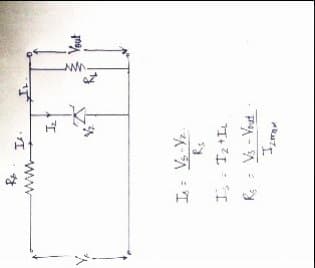How the Zener Works?
How the Zener works???
A P-N junction diode lets current flow in only one direction and needs to be installed in the correct direction. A zener is different than it. A Zener diode is placed in the opposite direction, against the flow of current. A Zener diode will prevent current from flowing until it reaches a certain voltage, depending on the diode rating. Diode rating or diode specification is its breakdown voltage VZ
Once it reaches it critical value, current is allowed to flow. The diode will also try to keep the outgoing voltage at its rated level, say 5 volts. If you feed 10 volts through the diode, the voltage might climb to 5.5-6 volts, but it will try to stay at the same voltage. If you feed too high a voltage through the diode, it will break down and fail.
Let’s take an application to understand in detail.
Zener as a Voltage regulator:
Voltage regulation means maintaining constant voltage at the output even if load current or input voltage varies.
For this the Zener is connected in parallel with the load element. A resister RS is necessary to limit the reverse current through the diode. A proper selection of the voltage source VS and RS is done so that the Zener works in the breakdown region. The diode voltage or the voltage across the load element RL is VZ and current is IZ .

1. As long as the voltage across the load element is less than the breakdown voltage, the Zener does not conduct.
2. The series resistor limits the zener current from exceeding its rated maximum.Current through RS
Is= (VS-VZ)/RS
3. The current from the power supply splits at the junction of the zener diode and load resistor RL . So IS = IZ+IL
4. VS: increases, Current through diode and load resistance: increases, then zener diode resistance decreases and current through the diode increases.
As a result a greater voltage drop will occur across the series resistance and the output voltage will be very close to the original value.
5. The zener diode will maintain the constant voltage across the load as long as the supply voltage is more than the zener voltage.
6. Vs: Constant, RL : decreases, IL : increases, thus IZ : decreases. Thus the output voltage again remains constant since the drop across series resistance is constant.
7. Advantage of using Zener as a voltage regulator is that they are smaller, rugged and have longer life. Also they are simple to construct and cheaper.
Hope, now working of Zener is clear.
A P-N junction diode lets current flow in only one direction and needs to be installed in the correct direction. A zener is different than it. A Zener diode is placed in the opposite direction, against the flow of current. A Zener diode will prevent current from flowing until it reaches a certain voltage, depending on the diode rating. Diode rating or diode specification is its breakdown voltage VZ
Once it reaches it critical value, current is allowed to flow. The diode will also try to keep the outgoing voltage at its rated level, say 5 volts. If you feed 10 volts through the diode, the voltage might climb to 5.5-6 volts, but it will try to stay at the same voltage. If you feed too high a voltage through the diode, it will break down and fail.
Let’s take an application to understand in detail.
Zener as a Voltage regulator:
Voltage regulation means maintaining constant voltage at the output even if load current or input voltage varies.
For this the Zener is connected in parallel with the load element. A resister RS is necessary to limit the reverse current through the diode. A proper selection of the voltage source VS and RS is done so that the Zener works in the breakdown region. The diode voltage or the voltage across the load element RL is VZ and current is IZ .

1. As long as the voltage across the load element is less than the breakdown voltage, the Zener does not conduct.
2. The series resistor limits the zener current from exceeding its rated maximum.Current through RS
Is= (VS-VZ)/RS
3. The current from the power supply splits at the junction of the zener diode and load resistor RL . So IS = IZ+IL
4. VS: increases, Current through diode and load resistance: increases, then zener diode resistance decreases and current through the diode increases.
As a result a greater voltage drop will occur across the series resistance and the output voltage will be very close to the original value.
5. The zener diode will maintain the constant voltage across the load as long as the supply voltage is more than the zener voltage.
6. Vs: Constant, RL : decreases, IL : increases, thus IZ : decreases. Thus the output voltage again remains constant since the drop across series resistance is constant.
7. Advantage of using Zener as a voltage regulator is that they are smaller, rugged and have longer life. Also they are simple to construct and cheaper.
Hope, now working of Zener is clear.
0
